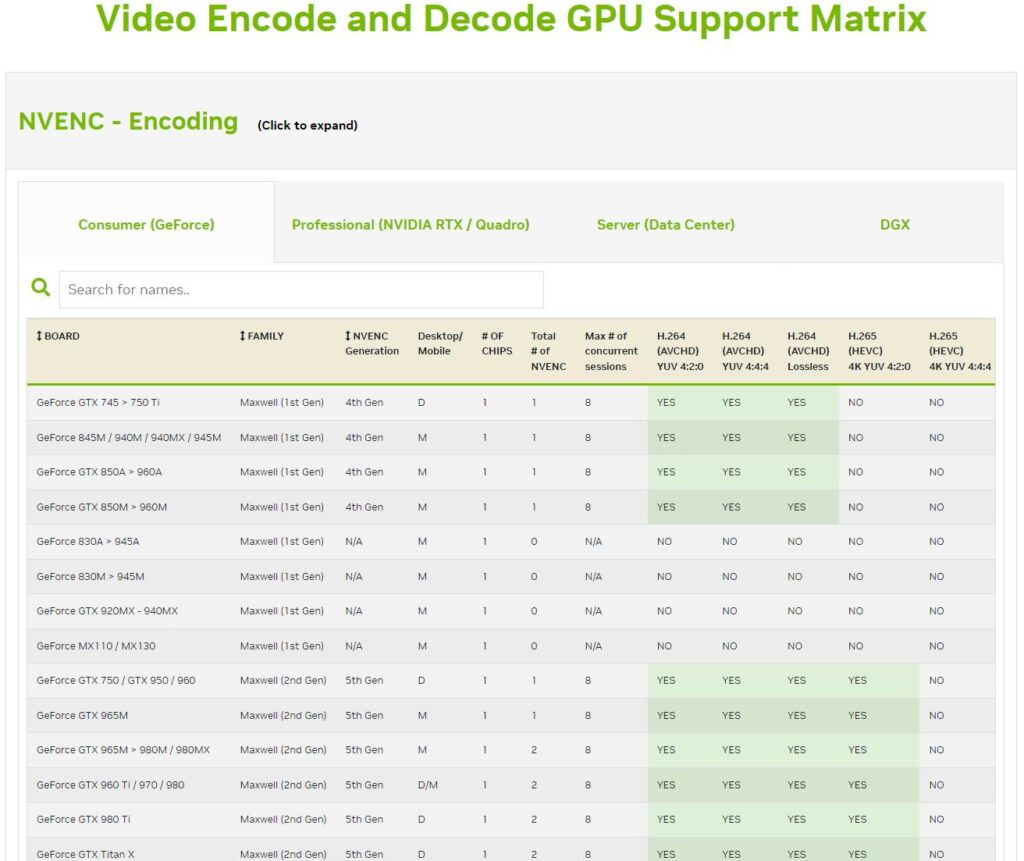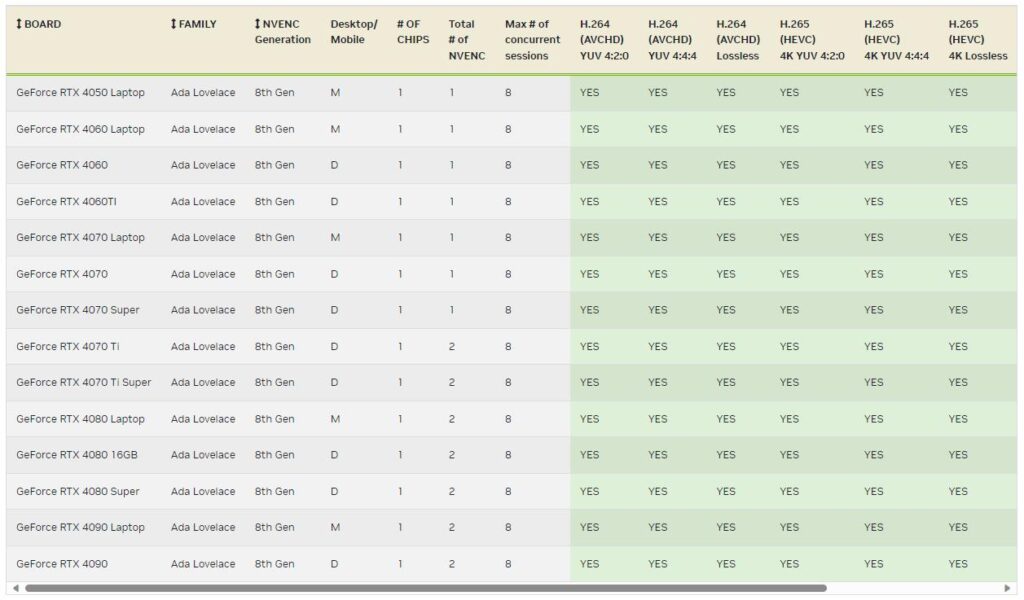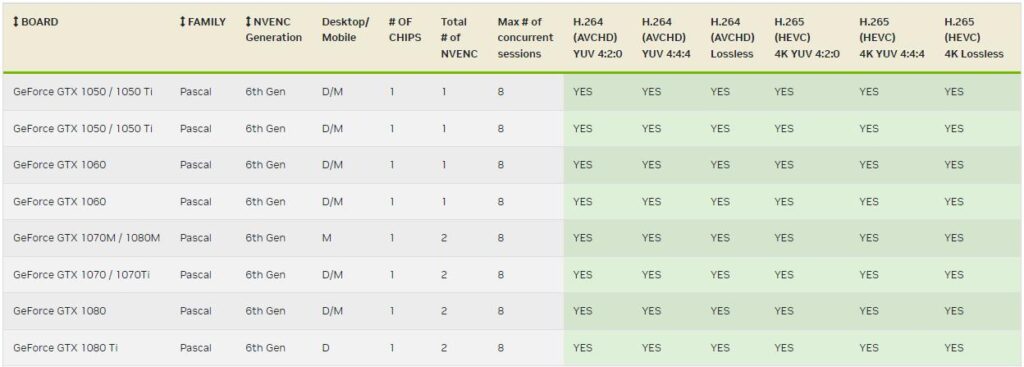Nvidia released Game Ready Driver 551.23 on January 24 to support the new RTX 4070ti Super graphics card and add new features like the RTX Video HDR enhancement. What wasn’t reported in the changelog for the driver update was an increase to the number of possible NVENC encoder sessions, bringing the cap up to 8 simultaneous sessions.
(In case you didn’t know, consumer GeForce cards have a driver limitation that caps the number of simultaneous video encodes you can perform on them. Historically, these GPUs were limited to 2 encodes at the same time, but in 2020 that limit was increased to 3, and then again in March of 2023 to 5 sessions.)

NVENC Update: All Nvidia GeForce Cards Quietly Updated to 8 Encoding Sessions!
Despite no formal announcement declaring the increase in concurrent sessions (there never is when they do this), the Video Encode and Decode GPU Support Matrix now reflects the updated capabilities. All NVENC-capable GPUs can encode up to 8 sessions before the driver starts to limit them.
…well all except one.

What a weird card.
I emphasized the driver limiting sessions there, as plenty of users will still hit a performance cap before 8 sessions are reached, without optimizing encode settings. Users hoping to push 8 different 1440p60 or 4K60 encodes with high-quality presets like P6 are going to be disappointed, all except the 4080-class cards may struggle. Quality juggling will absolutely be necessary here to get the most out of this update.

Support for 8 sessions surprisingly goes all the way back to the GTX 750ti! But GPUs that see the most benefit from this update will be RTX 4070ti and higher GPUs with dual encoders, as the encoder headroom on those cards is absolutely ridiculous.
However, the GTX 1070, GTX 1080 and GTX 1080ti (you know, the Pascal cards from 2016) see a benefit here, as well – these cards also had dual encoders! They weren’t used for fancy split-frame encoding at 4K and higher like the RTX 40 series cards, but they did provide a ton of additional encoding headroom that went mostly under-utilized with the 2 session limit without patched drivers for their time. Tragic.

Why change this now?
It might seem odd to quietly change this long-running (artificial) limitation this late, but it’s for a good reason.
Twitch and Nvidia announced at CES Twitch Enhanced Broadcasting: A complete revamp of the streaming pipeline between streamers and Twitch. This leverages an update to the Enhanced RTMP protocol used to stream to Twitch that allows for multitrack video, allowing the streamer to encode all of the different transcodes (lower quality/resolution versions) of their live stream locally and send to Twitch. This results in lower latency and higher-quality transcodes for the viewer – plus not having to configure stream settings yourself.
Naturally, this uses up encoder sessions. The current phase of the beta only encodes 3 transcodes right now, but Nvidia announced plans for at least 5 (reaching up to 4K60) and if streamers want to start utilizing newer codecs like AV1 and HEVC (once they become available, they’re not yet part of the Enhanced Broadcasting beta) they will need additional encoding sessions to still provide H264 copies of the stream for viewers who can’t access the new codecs.
There’s still a LOT of testing to be done with the Enhanced Broadcasting beta and balancing performance for everyone, but anyone concerned about using the new multitrack feature and still being able to record or multistream (requiring additional encodes) will have more flexibility with this update.
Perhaps it’s just self-serving for Nvidia to only bump up the cap when they have a new feature they’re trying to push, but we still benefit from it and supporting the bump on all NVENC GPUs is a huge win for older card users, especially those 1070/1080-class gamers.
This also benefits those of you running big multi-user Plex or Jellyfin servers that want to be able to transcode more movies or shows at once! (Though most of those users are probably already using the patched driver.)
Where do we go from here?
I’ve been saying for a while: It’s time for these GPUs to get better decode performance. While new codecs (VP9, AV1) have been added to the decode capabilities over time, the raw number of videos you could decode before running into performance issues has been small.
While not many users may be playing back a bunch of videos at the same time in-browser (though I can think of a couple scenarios where one might) this affects streamers who want dynamic stream layouts. These use video files as media sources, and you can only have a couple on one scene using hardware decoding before performance issues crop up – the rest have to have hardware decoding disabled.
It’s crazy to me that I can see 400+ FPS encoded in real-time in 4K with these newer cards, but can’t play back anywhere near that level of performance.
Come chat about this in the forums!

